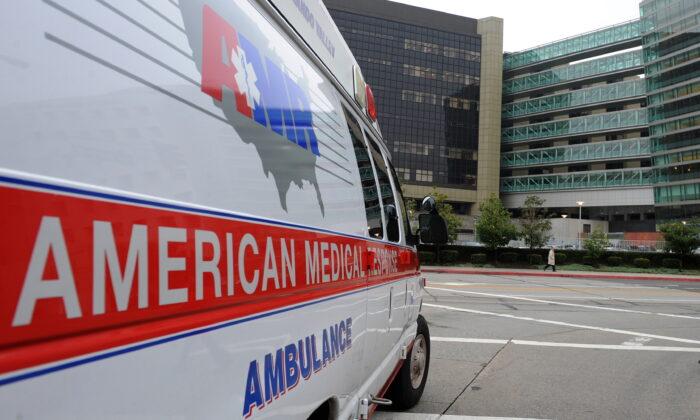Maternity units are reportedly on the decline in hospitals due to a decrease in staffing and low birth rates, leaving many in rural communities to have to drive up to 45 minutes to be served.
Hospital executive Dr. Michal Cruz told Wall Street Journal (WSJ) that the combination of low birth rates and staffing has made hospitals with minimal births “less attractive to doctors and nurses.”
“There’s just not enough babies to be had,” said Dr. Cruz, a chief operating officer for OSF HealthCare hospital system in Illinois.
According to a 2022 “Maternity Care Deserts Report” conducted by March of Dimes, in areas of the United States where there is little access or none to maternity units, almost 6.9 million and up to 500,000 births are impacted, which includes a 5 percent increase in counties that have reduced their access since 2020.
In maternity-care deserts, somewhere around 2.2 million women and up to 150,000 babies are impacted.
“It’s a crisis,” said Stacey Brayboy, the senior vice president of public policy and government affairs at March of Dimes, told Politico in March. “Women are struggling to access care, and that’s before and during and after their pregnancies, and we’ve seen an increase in terms of maternal and infant deaths.”
Alecia McGregor, an assistant professor of Health Policy and Politics at Harvard T.H. Chan School of Public Health, stated in March on The Wheelhouse, a Connecticut Public Radio podcast, that federal action is needed to halt the closures.
“The first solution is to put laws in place that stop maternity wards from closing as frequently as they are and as disproportionately in vulnerable communities as they are,” Ms. McGregor stated. “We need a payment system that increases payment levels for Medicaid. Medicaid should not be paying at rates that are much lower than other payers, which then gives incentives for hospitals to avoid communities with large proportions of Medicaid-insured patients. The federal government ought to encourage states to bring those levels up.”
Maternal Death Rates Could Increase
The WSJ report said the widespread closures could increase maternal death rates and send infant health into a deeper decline, both of which have hit record levels, making the U.S. “the most dangerous place among high-income countries to give birth.”
WSJ cited in a previous report a March survey from the National Center for Health Statistics stating that the number of women who died while or after giving birth rose 40 percent to 1,205 in 2021.
This is compared to 861 in 2020 and 754 in 2019, WSJ reported, which increased the maternal mortality rate to 33 deaths per 100,000 live births.
This is the highest it’s been since 1965, the WSJ reported, in comparison to 24 deaths per 100,000 in 2020 and 20 per 100,000 in 2019.
Closure in Oregon
Earlier this year, St. Alphonsus Medical Center in Baker City, Oregon, announced its intent to close the obstetrics and birth center department, according to a June press release from the Oregon Nurses Association (ONA).
“The hospital’s birth center serves approximately 125 families a year through labor, childbirth, recovery, bonding and parental education and training,” the report stated. “More than 90% of all babies born in Baker County are born at Saint Alphonsus Baker City.”
Local nurse and ONA advocate called the closure “heartbreaking.”
“It’s a 45-minute drive to the next hospital birth center and that’s if I-84 is even open,” she said. “We can’t tell people in labor to hold it. Nurses demand St. Alphonsus work with its health care providers and our communities’ families to keep our birth center open.”
According to ONA, St. Alphonsus closed the intensive care unit earlier this year as well, citing staffing shortages, lower patient projections, and financial trends.
St. Alphonsus, owned by Trinity Health, is the fifth largest health care system in the country, operating with an annual revenue of $21.5 billion, ONA said.
In July, Oregon U.S. Oregon Sens. Ron Wyden and Jeff Merkley sent a letter to the hospital asking that it reverse its decision to close the maternal units, offering federal, state, and local nursing service resources to help the hospital.
According to Oregon Public Broadcasting, the hospital’s response was to delay the closure by four weeks.
“Baker County residents have relayed their concerns about the impacts of families having to travel 45 miles to La Grande, through a mountain pass that can be treacherous in winter, if open at all, in order to receive maternity care,” the senators said. “The community highly values the maternity care provided by the hospital and is willing to work with you to keep the services in place. We understand staffing issues have been challenges for quite some time, yet the decision to quickly close the facility has left many in the community at a loss.”
Maternity units are reportedly on the decline in hospitals due to a decrease in staffing and low birth rates, leaving many in rural communities to have to drive up to 45 minutes to be served.
Hospital executive Dr. Michal Cruz told Wall Street Journal (WSJ) that the combination of low birth rates and staffing has made hospitals with minimal births “less attractive to doctors and nurses.”
“There’s just not enough babies to be had,” said Dr. Cruz, a chief operating officer for OSF HealthCare hospital system in Illinois.
According to a 2022 “Maternity Care Deserts Report” conducted by March of Dimes, in areas of the United States where there is little access or none to maternity units, almost 6.9 million and up to 500,000 births are impacted, which includes a 5 percent increase in counties that have reduced their access since 2020.
In maternity-care deserts, somewhere around 2.2 million women and up to 150,000 babies are impacted.
“It’s a crisis,” said Stacey Brayboy, the senior vice president of public policy and government affairs at March of Dimes, told Politico in March. “Women are struggling to access care, and that’s before and during and after their pregnancies, and we’ve seen an increase in terms of maternal and infant deaths.”
Alecia McGregor, an assistant professor of Health Policy and Politics at Harvard T.H. Chan School of Public Health, stated in March on The Wheelhouse, a Connecticut Public Radio podcast, that federal action is needed to halt the closures.
“The first solution is to put laws in place that stop maternity wards from closing as frequently as they are and as disproportionately in vulnerable communities as they are,” Ms. McGregor stated. “We need a payment system that increases payment levels for Medicaid. Medicaid should not be paying at rates that are much lower than other payers, which then gives incentives for hospitals to avoid communities with large proportions of Medicaid-insured patients. The federal government ought to encourage states to bring those levels up.”
Maternal Death Rates Could Increase
The WSJ report said the widespread closures could increase maternal death rates and send infant health into a deeper decline, both of which have hit record levels, making the U.S. “the most dangerous place among high-income countries to give birth.”WSJ cited in a previous report a March survey from the National Center for Health Statistics stating that the number of women who died while or after giving birth rose 40 percent to 1,205 in 2021.
This is compared to 861 in 2020 and 754 in 2019, WSJ reported, which increased the maternal mortality rate to 33 deaths per 100,000 live births.
This is the highest it’s been since 1965, the WSJ reported, in comparison to 24 deaths per 100,000 in 2020 and 20 per 100,000 in 2019.
Closure in Oregon
Earlier this year, St. Alphonsus Medical Center in Baker City, Oregon, announced its intent to close the obstetrics and birth center department, according to a June press release from the Oregon Nurses Association (ONA).“The hospital’s birth center serves approximately 125 families a year through labor, childbirth, recovery, bonding and parental education and training,” the report stated. “More than 90% of all babies born in Baker County are born at Saint Alphonsus Baker City.”
Local nurse and ONA advocate called the closure “heartbreaking.”
“It’s a 45-minute drive to the next hospital birth center and that’s if I-84 is even open,” she said. “We can’t tell people in labor to hold it. Nurses demand St. Alphonsus work with its health care providers and our communities’ families to keep our birth center open.”
According to ONA, St. Alphonsus closed the intensive care unit earlier this year as well, citing staffing shortages, lower patient projections, and financial trends.
St. Alphonsus, owned by Trinity Health, is the fifth largest health care system in the country, operating with an annual revenue of $21.5 billion, ONA said.
In July, Oregon U.S. Oregon Sens. Ron Wyden and Jeff Merkley
sent a letter to the hospital asking that it reverse its decision to close the maternal units, offering federal, state, and local nursing service resources to help the hospital.
According to Oregon Public Broadcasting, the hospital’s response was to delay the closure by four weeks.
“Baker County residents have relayed their concerns about the impacts of families having to travel 45 miles to La Grande, through a mountain pass that can be treacherous in winter, if open at all, in order to receive maternity care,” the senators said. “The community highly values the maternity care provided by the hospital and is willing to work with you to keep the services in place. We understand staffing issues have been challenges for quite some time, yet the decision to quickly close the facility has left many in the community at a loss.”





